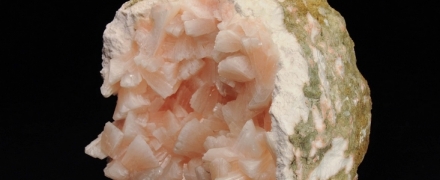open 10 am - 7 pm
laboratory is closed
More about zeolites

We have already written about the use of such minerals of the zeolite family as natrolite and scolecite for the manufacture of faceted jewelry inserts. Now we will consider the zeolites of the heulandite group - heulandites and stilbites. As a rule, the minerals of these series do not form transparent crystals or areas in crystals suitable for the manufacture of faceted inserts, and are most often used for the manufacture of filters. But often their aggregates have a beautiful pearly sheen in the white variety, and in a number of varieties they have delicate color tones. Such stones look very attractive in a cabochon cut. Their hardness on the Mohs scale is low - 3.5-4, but in the raw materials used for cutting it is compensated by the viscosity of the aggregate. Of course, most often such cabochons can be seen in the form of inserts in inexpensive silver jewelry and most often in earrings.
В геммологической практике бывают весьма увлекательные случаи с диагностикой ювелирных вставок
Но помимо редкости цвета и высокой стоимости таких камней, многие розовые камни выделяются одной замечательной особенностью – они проявляют плеохроизм, то есть в зависимости от положения осмотра камня он может иметь дополнительные оттенки – оранжевый или пурпурный.
Currently, gemstones are produced by two fundamentally different technological methods - the High Pressure - High Temperature method (“HPHT”, High-pressure & High-temperature) and the Chemical Vapor Deposition (“CVD”, Chemical vapor deposition) method. The "HPHT" method is the most tested classical synthesis method, which can be used both carbon deposition on diamond from flux melts and catalytic reactions. In "CVD" synthesis, diamond growth occurs on a seed during carbon deposition mainly from a gaseous medium at relatively low temperatures and pressures.
Jewelry and precious stones are just such a category of goods, when buying which you need to pay attention to many criteria.
Sogdianite is a rather rare mineral and more often it can be found as a collection material (moreover, in systematic collections), and it is extremely rare in jewelry.






